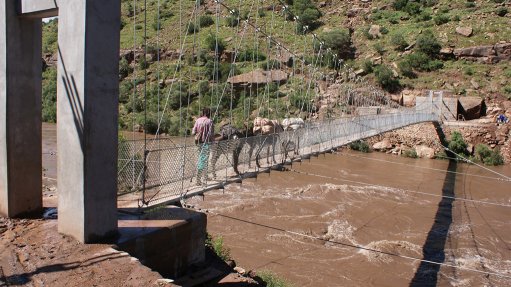
HA MOFUTHO BRIDGEThe design of the bridge focused on job creation and the development of the local construction industry, as part of the client’s requirements
Consulting engineering firm Royal HaskoningDHV’s HA Mofutho bridge has won the Hot-Dip Galvanizers Association of Southern Africa award for infrastructure and community development, as well as the prominent WGS Barnett trophy.
The awards ceremonies were held last month in Fourways, Johannesburg.
Royal HaskoningDHV was appointed by the Lesotho Ministry of Public Works and Transport to undertake engineer- ing investigations, the design and preparation of detailed drawings and tender documents, as well as the site supervision for the construction of a pedestrian bridge across the Senqu river, near the village of HA Mofutho, in Quacha’s Nek district, a remote area in Lesotho.
The 80-m-long and 1.2-m-wide bridge is used by pedestrians and domestic animals between the villages of HA Mofutho and HA Makhaola and allows villagers to access markets for their shopping and to find employment.
Royal HaskoningDHV project principal Gerrit Visser tells Engineering News that, previously, small boats were used to cross the river when water levels were low. However, crossing in the rainy season was hazardous as a result of fast-flowing water and high water levels.
“The villagers now have safe access to employment and markets and can communicate with the outside world. Because of this natural barrier, village communities were effectively isolated, which perpetuated poverty, ignor- ance and health issues,” he states.
The project began in February 2010 and was completed in December 2010.
The design of the bridge focused on job creation and the development of the local construction industry, as part of the client’s requirements, which also stated that the bridge had to be aesthet- ically pleasing, environment-friendly, durable and easy to maintain.
“The challenges of the project were its location and the transport of materials – not only because of transport across the South Africa-Lesotho border, but also at the site itself, as a result of the extremely steep sides of the ravine. Although a road was constructed for the purpose of transporting materials to the site, it was only on one side of the river and limited to light vehicles, such as bakkies, and the original design took into account that bridge components might have to be transported by donkey,” Visser explains.
The final plan comprised two foundation bases for the main pylons, with six mass concrete anchor blocks for the cable stays.
Galvanised structural steel was used to construct the bridge deck, as it was manufactured and erected in sections and transported by mules and small delivery vehicles. It was also easy to erect and did not require the use of a crane.
Visser says the galvanising complemented the structural steel and provided the client with a durable and low-maintenance structure.
“In preparation for the project, Royal HaskoningDHV conducted workshops for the local indigenous contractors to transfer knowl- edge and ensure that they benefited in every way. Further workshops for the engineers from the roads directorate provided for skills transfer and have left a legacy of understanding and goodwill, which will be remembered for many years,” he concludes.